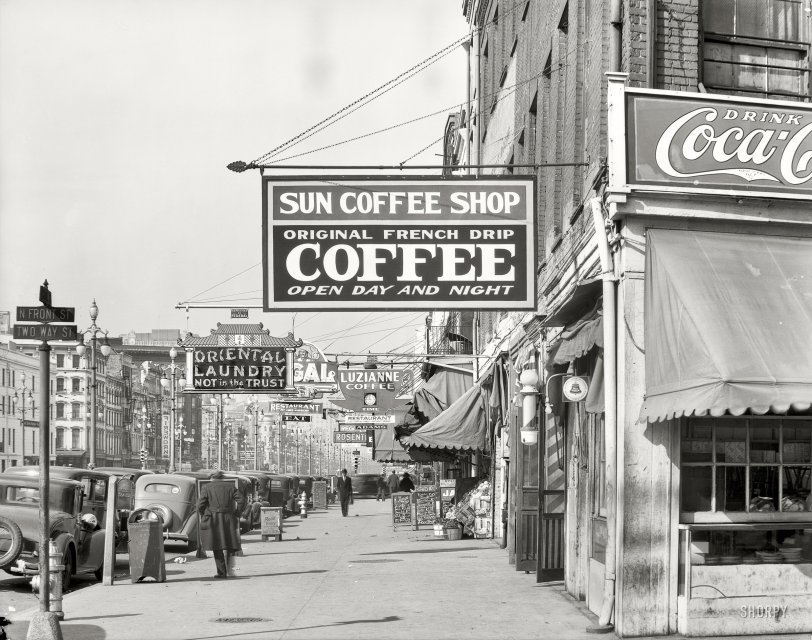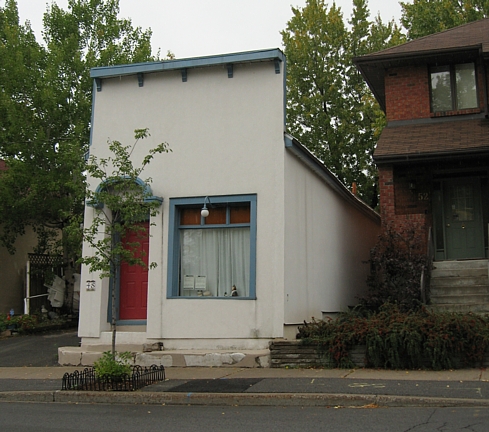


Framed or unframed, desk size to sofa size, printed by us in Arizona and Alabama since 2007. Explore now.
Shorpy is funded by you. Patreon contributors get an ad-free experience.
Learn more.

- What a headache!
- Baldwin 62303
- Baldwin VO-1000
- Cold
- No expense spared
- Tough Guys
- Lost in Toyland
- And without gloves
- If I were a blindfolded time traveler
- Smoke Consumer Also Cooks
- Oh that stove!
- Possibly still there?
- What?!?
- $100 Reward
- Freeze Frame
- Texas Flyer wanted
- Just a Year Too Soon
- WWII -- Replacing men with women at the railroad crossing.
- Yes, Icing
- You kids drive me nuts!
- NOT An Easy Job
- I wonder
- Just add window boxes
- Icing Platform?
- Indiana Harbor Belt abides
- Freezing haze
- Corrections (for those who care)
- C&NW at Nelson
- Fallen Flags
- A dangerous job made worse
Print Emporium
Sun Coffee Shop: 1935

December 1935. "New Orleans, downtown street." North Front at Canal. Nitrate negative by Walker Evans for the Farm Security Administration. View full size.
Chinese Hand Laundries
My Father the Laundryman, always complained about the Chinese Hand Laundries in NYC. He once said to me that he was convinced that Chinese Government subsidized those businesses so they were able to undercut the pricing of the regular (White) owned shops. They really weren't his competition because they couldn't afford the rents on the Upper West Side of Manhattan. The reason they could do it so cheaply was, simply that the overhead was much lower. Their shops were in mainly in less affluent residential areas. The usually lived in or above the store and employed no help. The entire family worked, the husband marked the incoming wash, with those indelible ink characters, used to identify the customer, found usually on the inside of the article to be laundered. The pair after laundering the clothes then ironed them. The children did other tasks including pick up and delivery. All meals were taken on the premises. They never got rich but the children all went to the public school and many continued to High School. I think most of us are familiar with the 3rd generation and their accomplishments in this country.
Re: "Oriental" Laundry
In 1959-60 I lived in New Orleans, on St. Charles street, between Canal and Lee Circle, maybe 6-7 blocks from the Sun Coffee Shop corner shown above. My then employment required white dress shirts. One block down St. Charles and across the street from me was what I called a Chinese laundry. I would leave my shirts and get them back wrapped in a brown paper package tied with white string.
In the 1990s I saw the play "Driving Miss Daisy." I was astounded to see, as a prop, laundry returned in brown paper tied with white string. Until then I'd never realized that was probably a common practice.
I lived about two blocks toward Lee Circle from the Liberty Theatre. https://www.shorpy.com/node/5786 The Liberty and another theatre close by were still open when I was there.
The Dream Factory
The above New Orleans "Sun Coffee Shop" photo is shown in "Hollywood: The Dream Factory" (TV 1972). It's meant to show a scene of the 1930s depression. It immediately follows a "Hollywood Party" with women dancing, literally, on tables.
It's at 2:35+ in this YouTube video: https://www.youtube.com/watch?v=83cqJPwlvQA
===
Happy New Year, Shorpy, Dave, and all!
I Love This Site
Thanks for this wonderful photo. I grew up in Metairie, 20 mins from New Orleans - but really I'm from that sweet old city New Orleans. This photo along with the others on this site are inspiring me to do a painting. Thank you so much!
Popular Among the Poor
Oftentimes in the South of antiquity, and I suppose the process was developed during the Civil War as a result of the Union blockade, a substitute for coffee was chicory. A brew from it would be syrupy, bitter, and quite strong, but sometimes ya gotta do what'cha gotta do. Chicory coffee is still popular today in some areas of the South.
French Drip
Coffee made in a two-part pot. The bottom has a spout and handle and it is capped with a small pot with a lid.... You put the coffee in the top pot and and boiling water is poured over the grounds. They then drop down into the bottom pot. It is/was the favoured coffee in Louisiana.
Pots were hard to get for a long time but the popularity is again on the upswing and there are pots again being made.
Here is a poem about making the coffee...
Jax Beer sign
Not to mention the more picturesque neon Regal Beer sign.
French Drip
Not to be confused with French Press. The French Drip coffee maker consists of a pot from which you serve and the top part which contains the coffee grounds. Pour the hot water into the top portion and allow the water to drop through the grounds infusing the flavour into the water. continue to add water until the desired amount of coffee is made. Similar to the way that most coffee makers today operate, but when you realize that in the day most coffee was either percolated or served out of those big urns you can see why they advertised the more labour intensive (but better tasting) process.
Very exotic
What, I wonder, is "French Drip Coffee"?
Jax and Barq's
I find it interesting that the tradition of being able to get a beer anywhere in New Orleans stretches back as far as anyone can remember, which is very much uncommon in the rest of the South. Does anyone else see the partially hidden Jax Beer sign?
I also like that the Barq's Root Beer logo hasn't changed in 75 years, in those days Barq's was a Southern Mississippi and South Louisiana beverage with the Biloxi, New Orleans, and Baton Rogue bottlers each having slightly different syrup formulas. Sadly, I'm too young to have experienced the old Third Coast.
Signs on signs.
Interesting in that some of the poles carrying the advertising signs have smaller signs advertising the fact that they maintain the signs!
Barq's has bite
Barq's Root Beer on the chalk sidewalk sign, didn't know Barq's was that old.
All gone
The city of my birth and it probably didn't look much different in 1948 when I made my appearance. Canal Street and North Front don't meet up today; Saks Fifth Avenue is on this corner and Harrah's Casino is across the street.
At 921 Canal St was the wonderful New Orleans department store Maison Blanche where we would go for photos with Santa and his sidekick Mr Bingle. Today it's the Ritz Carlton. I have to find one of our Santa photos.
Arthur Brisbane was one of the most important newspapermen of the early 20th century and worked for Hearst, but would die a year after this photo was taken. The Daily States would disappear by 1962 in a newspaper merger.
Dang!`
Wish that pedestrian wasn't blocking our view of the menu board.
Also, wonder when New Orleans got the tri-color traffic signals.
Bang
And how often today do you see a huge "FIREWORKS" sign?
[Well, if you live down South ... - Dave]

Chinese Laundry
Chinese Laundries were ubiquitous in most cities. There was one in our neighbourhood when I was a kid but it closed in the very late 60s.
The building is still there but I doubt that the people who live in the remodelled and upscale building know its history.
I can still remember the tubs sitting outside the building at the back that was the actual wash-house, also turned into a pied-a-terre.
The photo was taken before its latest refurb.

Getting your message across
The lengths they've gone to, extending so many signs closer to the street and car traffic, it seems. I imagine the first business to extend their sign outwards by about 10-15 feet caused the many others to do the same. Looks like the Oriental Laundry is ahead right now.
Luzianne
I actually drink Luzianne coffee, but I didn't know the brand was that old.
The City That Never Sleeps
New Orleans looks to be one well-caffeinated town!
Bohn Ford still there
One of the Fords in the foreground has "BOHN" on the spare tire cover. Bohn Ford (now Don Bohn Ford) is still there, located on the West Bank in Harvey. In the '70s they were Dick Bohn Ford (no snide remarks, please).
Also, it looks to me like the sign for the cross street is Canal. Today that's where the Harrah's casino is located.
Untrustworthy Laundry
Another wonderful Shorpy picture packed with detail! I'm curious about the laundry sign in the centre of the the picture; they are advertising that they are "Not in the trust." Can anyone shed light on what this phrase refers to?
[It means the business is not part of a price-fixing cartel. - Dave]
























On Shorpy:
Today’s Top 5